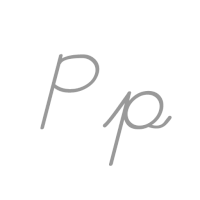P
P, or p, is the 16th letter of the modern English alphabet and the ISO basic Latin alphabet. Its name in English is pee (pronounced /ˈpiː/), plural pees.[1]
| P | |||
|---|---|---|---|
| P p | |||
| (See below) | |||
 | |||
| Usage | |||
| Writing system | Latin script | ||
| Type | Alphabetic and Logographic | ||
| Language of origin | Latin language | ||
| Phonetic usage | [p] [pʰ] [(p)f] [pʼ] [b] /piː/ | ||
| Unicode codepoint | U+0050, U+0070 | ||
| Alphabetical position | 16 | ||
| History | |||
| Development |
| ||
| Time period | ~-700 to present | ||
| Descendants | • Ᵽ • ₱ • ℘ • ℗ • ♇ • ꟼ • 𐍀 | ||
| Sisters | Π π Ⲡ П פּ פ ף ف ܦ پ ࠐ 𐎔 በ ጰ ፐ Պ պ | ||
| Variations | (See below) | ||
| Other | |||
| Other letters commonly used with | p(x), ph | ||
|
History
The Semitic Pê (mouth), as well as the Greek Π or π (Pi), and the Etruscan and Latin letters that developed from the former alphabet, all symbolized /p/, a voiceless bilabial plosive.
| Phoenician P |
Archaic Greek Pi |
Greek Pi |
Cyrillic Pe |
Etruscan P |
Latin P |
|---|---|---|---|---|---|
Use in writing systems

In English orthography and most other European languages, ⟨p⟩ represents the sound /p/.
A common digraph in English is ⟨ph⟩, which represents the sound /f/, and can be used to transliterate ⟨φ⟩ phi in loanwords from Greek. In German, the digraph ⟨pf⟩ is common, representing a labial affricate /pf/.
Most English words beginning with ⟨p⟩ are of foreign origin, primarily French, Latin, Greek, and Slavic; these languages preserve Proto-Indo-European initial *p. Native English cognates of such words often start with ⟨f⟩, since English is a Germanic language and thus has undergone Grimm's law; a native English word with initial /p/ would reflect Proto-Indo-European initial *b, which is so rare that its existence as a phoneme is disputed.
However, native English words with non-initial ⟨p⟩ are quite common; such words can come from either Kluge's law or the consonant cluster /sp/ (PIE *p has been preserved after s).
In the International Phonetic Alphabet, /p/ is used to represent the voiceless bilabial plosive.
Related characters
Ancestors, descendants and siblings
The Latin letter P represents the same sound as the Greek letter Pi, but it looks like the Greek letter Rho.
- 𐤐 : Semitic letter Pe, from which the following symbols originally derive
- Π π : Greek letter Pi
- 𐌐 : Old Italic and Old Latin P, which derives from Greek Pi, and is the ancestor of modern Latin P. The Roman P had this form (𐌐) on coins and inscriptions until the reign of Claudius, ca. 50 AD (See also Claudian letters).
- 𐍀 : Gothic letter pertra/pairþa, which derives from Greek Pi
- П п : Cyrillic letter Pe, which also derives from Pi
- Ⲡ ⲡ : Coptic letter Pi
- Պ պ: Armenian letter Pe
- Π π : Greek letter Pi
- P with diacritics: Ṕ ṕ Ṗ ṗ Ᵽ ᵽ Ƥ ƥ ᵱ[2] ᶈ[3]
- Uralic Phonetic Alphabet-specific symbols related to P:[4]
- U+1D18 ᴘ LATIN LETTER SMALL CAPITAL P
- U+1D3E ᴾ MODIFIER LETTER CAPITAL P
- U+1D56 ᵖ MODIFIER LETTER SMALL P
- ₚ : Subscript small p was used in the Uralic Phonetic Alphabet prior to its formal standardization in 1902[5]
Derived ligatures, abbreviations, signs and symbols
- ₱ : Philippine peso sign
- ℘ : script letter P, see Weierstrass p
- ℗ : sound recording copyright symbol
- ♇ : Pluto symbol
- ꟼ : Reversed P was used in ancient Roman texts to stand for puella (girl)[6]
- Ꝑ ꝑ, Ꝓ ꝓ, Ꝕ, ꝕ : Various forms of P were used for medieval scribal abbreviations[7]
Computing codes
| Preview | P | p | ||
|---|---|---|---|---|
| Unicode name | LATIN CAPITAL LETTER P | LATIN SMALL LETTER P | ||
| Encodings | decimal | hex | decimal | hex |
| Unicode | 80 | U+0050 | 112 | U+0070 |
| UTF-8 | 80 | 50 | 112 | 70 |
| Numeric character reference | P | P | p | p |
| EBCDIC family | 215 | D7 | 151 | 97 |
| ASCII 1 | 80 | 50 | 112 | 70 |
- 1 Also for encodings based on ASCII, including the DOS, Windows, ISO-8859 and Macintosh families of encodings.
Other representations
See also
- Mind your Ps and Qs
- Pence or "penny," the English slang for which is p (e.g. "20p" = 20 pence)
References
- "P", Oxford English Dictionary, 2nd edition (1989); Merriam-Webster's Third New International Dictionary of the English Language, Unabridged (1993); "pee," op. cit.
- Constable, Peter (2003-09-30). "L2/03-174R2: Proposal to Encode Phonetic Symbols with Middle Tilde in the UCS" (PDF).
- Constable, Peter (2004-04-19). "L2/04-132 Proposal to add additional phonetic characters to the UCS" (PDF).
- Everson, Michael; et al. (2002-03-20). "L2/02-141: Uralic Phonetic Alphabet characters for the UCS" (PDF).
- Ruppel, Klaas; Aalto, Tero; Everson, Michael (2009-01-27). "L2/09-028: Proposal to encode additional characters for the Uralic Phonetic Alphabet" (PDF).
- Perry, David J. (2006-08-01). "L2/06-269: Proposal to Add Additional Ancient Roman Characters to UCS" (PDF).
- Everson, Michael; Baker, Peter; Emiliano, António; Grammel, Florian; Haugen, Odd Einar; Luft, Diana; Pedro, Susana; Schumacher, Gerd; Stötzner, Andreas (2006-01-30). "L2/06-027: Proposal to add Medievalist characters to the UCS" (PDF).




